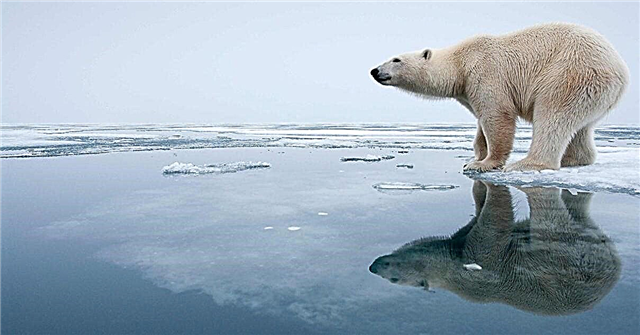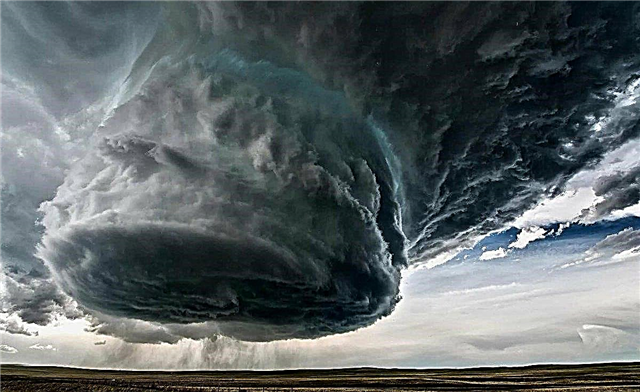
Already in ancient Greece, in general terms, they had an idea about the structure of the Earth. Now, thanks to the first round-the-world trips, and the painstaking research of subsequent scientists, we have such a detailed globe and maps.

But in 1933, Otto Christopher Hilgenberg, combining the continents along the coastlines, received a new globe, but it was 55-60% smaller than the real one. At first, many world scientists approved his idea approvingly, because it seemed obvious to everyone who carefully examined the globe and was surprised at the coincidence of the coastlines of the continents. Moreover, there is a generally accepted theory of the existence of a single continent, called "Pangea." Yes, and practical studies confirmed the identity of the rocks that make up the earth's crust in compatible areas, so the Hilgenberg globe was so attractive.

The theory of “continental drift” then already existed, although the author of this theory Alfred Wegener doubted its reality, so Hilgenberg’s theory made it possible to clarify that there was no drift as such, but the size of the Earth gradually increased with the formation of the oceans and the continents moved away from each other. But then this idea was rejected, as if by a deadly argument: if the initial diameter of the Earth was less, then where did the mass come from to increase its volume?

It should be noted that there were plenty of examples of expanding the volume of the substance, with constant mass at that time, but apparently they were considered unconvincing. However, the modern theory of the expanding Earth is based on other scientific material.
The Expanding Earth Hypothesis
In the early seventies, when they talked about the finiteness of oil reserves, the search began for other energy sources than oil, gas and coal. An amazing discovery was made: more than a thousand volumes of hydrogen can dissolve in one volume of a metal melt! Such a solid solution is called metal hydride. That's just to realize such a battery is extremely difficult and costly. Although burning hydrogen in oxygen to produce water is a very tempting idea to produce clean energy! However, the Soviet scientist Vladimir Nikolaevich Larin drew attention to this fact. It is generally accepted in scientific circles that the earth’s core consists, like a meteorite substance, of an alloy of metals and the presence of a large amount of dissolved hydrogen in it can very much increase the mass of the earth’s core against the calculated one.

But the obvious question arises: on what basis is the presence of hydrogen in the earth’s core supposed?
Science has established that the Universe is 90% hydrogen, 10% helium, and only 0.1% is accounted for by other chemical elements. That is, there is absolutely not enough hydrogen on Earth by universal standards! Here V. Larin quite justifiably and suggested that a colossal amount of hydrogen was dissolved in the earth’s core and this circumstance significantly increases the density of the earth’s core. That is why the denser substance of the earth’s core in prehistoric times occupied a much smaller volume.
According to various estimates, from 500 to 250 million years ago, hydrogen began to be released from the earth's core. Scientists know that the chemical activity of hydrogen as a reducing agent is higher than oxygen as an oxidizing agent. Therefore, hydrogen, "purging" the bowels, took oxygen from the earth's crust oxides and formed water, and this process continues to this day.
Where did water come from on earth?

The modern research of metallurgical scientists S.V. Digonsky and V.V. Ten, in the book "Unknown Hydrogen" indicates how hydrogen from the earth's interior is involved in the creation of oil, natural gas, coal and even diamonds. Understanding of these processes described in the book is quite accessible for people with technical education.
It is ironic that scientists are more concerned about the origin of hydrocarbons, coal and diamonds, and not water, although life is impossible without water, and people have lived without oil for thousands of years. It is water scarcity in many regions of the earth that exacerbates interstate relations. Yes, and in Russia there are no clear explanations of the shallowing of the Volga and Lena rivers in the summer of 2019. Therefore, let us leave the questions of the origin of oil, coal, and diamonds for now and trace the formation of water.
Most paleontologists believe that water on the earth appeared 500 million years ago, since sedimentary layers created with the participation of water did not appear earlier than this time, although the total age of the Earth is 4 - 4.5 billion years. The petrified remains of ancient animals and plants also date to a later age.
Wikipedia estimates the amount of all water on Earth to be about 1.5 trillion. km3. Dividing this volume by 500 million years, we find (of course, not claiming the scientific nature of this calculation) that approximately 3,000 km3 of water is formed per year. Since the water surface is 70% of the entire earth's surface, water sources should also be at the bottom. And the latest deep-sea studies have surprised them to discover. Scientists called them "black smokers", although theoretically there should not be sources of water!
So, water appeared on Earth from sources rising from the bowels of the earth and filled the Pangea with waters, forming the Tethys Ocean. With the advent of water, life appeared, which also coincides with the opinion of most scientists that life originated in the sea, and on earth there was a time of general flooding of land. That is, the new theory does not cancel existing theories, but only interprets geological events differently!
But the outflow of hydrogen from the earth's core lowered its density, thereby causing an increase in volume, and this caused tension in the bowels and led to the rupture of the earth's crust in many places. These faults of the crust are clearly traced and plotted on maps of the Earth. As the formation of water continues, the continual expansion of the earth's interior continues with the formation of a new crust. The same reason also explains volcanism, which causes earthquakes from the expansion of old faults and the formation of new ones.

By studying volcanoes and measuring the composition of volcanic emissions, scientists discovered the presence of water vapor, hydrocarbons and hydrogen itself, as well as other substances that, according to the theory of the biogenic (i.e. organic) origin of hydrocarbons, should not be there. Therefore, the term “subduction” was coined — the phenomenon of “diving” of an oceanic plate mastered by living organisms, under a mainland plate. From this, supposedly remelted organic materials are then thrown out along with magma by volcanoes. This statement cannot be called scientific, since Wikipedia does not even name the author the term “subduction”.
But the presence of organic substances in volcanic emissions is just a very important argument for the fact that in the bowels of the earth from the contact of hydrogen with other elements water and methane (CH4) are formed, which is synthesized, under conditions of high temperatures and pressure, into complex hydrocarbons. It is appropriate to mention here that the metallurgical scientist S.V. Digonsky in his book indicates the ubiquity of hydrogen in all chemical reactions, including the formation of terrestrial rocks and minerals.
I must explain my interest in the subject, as a former oilman, caused by several circumstances: firstly, I read A. Yu. Sklyarov's book “Sensational History of the Earth”. First, a chapter on the abiogenic origin of oil and coal, and then three times the entire book. Secondly, I saw in Odnoklassniki a picture of a petrified tree on Krestovaya Mountain in Gubakha and was very puzzled, since it is considered an indisputable truth that the Ural Mountains formed at the bottom of the Perm Sea! But at the bottom of the sea, trees do not grow and do not drown there. These two circumstances prompted me to search the Internet.
Imprints of petrified wood
Thirdly, I found in information on general geology a lot of inaccuracies and illogical, or even simply strange, assumptions like “subduction”. Finally, as someone who was born in Kungur, I often had to visit the Kungur ice cave and since childhood I was surprised at the “illogicality” of the behavior of water, which dissolved such a large cave not with a straight corridor, but with strange ledges, but for some reason it does not dissolve Ice Mountain outside, although For thousands of years, the Sylva River washes the banks of carbonate mountains.
Having appeared in the fall of 2019, he went to the geological museum in Yekaterinburg and saw a petrified stump in the vestibule of the entrance to the museum. The museum also has a large number of petrified fragments of trees, and even with a similar bark, as in the Gubakha picture. Logically, it should be difficult to notice a stone in a stone, but these findings suggest that there are many wood fossils in the Urals.
In fairness, it must be said that in the Kungur oil storage facility of the oil industry there are cores (rock samples) with petrified remains of aquatic animals, but they were extracted from great depths, that is, from a rock formed many years ago. In other words: the base of the Urals most likely formed at the bottom of the sea from reef deposits, but the upper layers were formed only on the land surface.
Resting in Turkey, I know that there is such a tourist site "Pamukkale", white cliffs - this name is translated from Turkish. There is a source of mineralized water on the mountain, and this water spreads over the cliffs of the mountain and limestone settles from the water, creating these rocks. It’s easy to see in Google the picturesque nature of this place, but I was wondering if one of the trees in the photo near the limestone deposits could eventually be under a layer of carbonate deposits. And he was convinced: yes, and not just be able to, but already have such trees whose rhizomes are under a layer of limestone.

It appears on these deposits two thousand years ago was the city of Hierapolis, which has a wonderful history, but was completely destroyed by the 1354 earthquake. The city had an extensive necropolis and one of the crypts was in the zone of limestone deposition, so it was almost absorbed by stone, or rather, brought in deposits of more than a meter!

The shortness of the excursion did not allow me to get accurate information, but suppose that the crypt was 2000 years old and during that time a meter of limestone was deposited. For one hundred thousand years, 50 meters will be deposited, for a million - a mountain, for 100 million - a mountain system!
One of the professional geologists, in response to my arguments, condescendingly explained that yes, the upper deposits of carbonates were formed from the redeposition of previously formed ones. This is of course difficult to argue with, but one must keep in mind the law of conservation of substances in nature: if it arrives somewhere, then in another place it will be taken away. If we were talking about tens or hundreds of meters of sediment, but tell me: where were carbonate sediments several kilometers high and hundreds of millions of square kilometers in area?
But from the theory of the expanding Earth we get the same logical answer: hydrogen flows from the bowels of the earth, forms water, water, being a good solvent, carries carbonates that are deposited on the surface. Often, water flowing from the depths contains carbon dioxide, which significantly increases the solubility of already deposited carbonates, so caves, as well as the so-called "organ pipes" are formed in them. Each time the sediment reaches a height at which the pressure in the lower part of the cave exceeds the hydraulic fracturing pressure, water from the entire cave begins to flow in a new place and the mountain begins to deposit from this new source. That is, what cavers call the entrance to the cave, in fact, the exit of the water that formed the cave.
That is why the entrance is usually a narrow hole, and the cave not only has huge grottoes, but often underground rivers and lakes, which have siphons in deeper and water-filled cavities, as well as numerous "organ pipes", many of which later collapse from accumulating on wet soil surface. However, this does not at all preclude the penetration of surface atmospheric precipitation into the caves and the formation of underground rivers. Many sources originate from drops of water leaked into the caves.
But in the world there are also many vluices - sources whose nutrition area has not been clarified.They got their name from the French source Vaucluse, which does not dry out even in times of severe drought. With a high degree of probability they can be considered newly formed in the bowels of the water.
But let us turn again to the Urals. With a decrease in the curvature of the surface of the continents from the expanding Earth, they experienced an ever-increasing stress. And at some point, Eurasia split in the Urals. However, the formation of a new crust did not occur here, as in the ocean, but the upflows carried a huge amount of carbonates, clay and volcanic material, creating the Ural Mountains, and in them - mineral deposits. And earthquakes in the Urals also happen.
The fact of breaking the mainland platform into the European and Asian parts is also confirmed by the oldest Ural doctor of mineralogy, Prokin Vasily Alexandrovich.
Clay deposits of the main and ultrabasic composition penetrate into the caves of the Urals with water flows and diamond geologists V.A.Smirnov and N.P. Razumova also note in their field studies.
The size of the article does not allow us to describe the mechanisms of formation of oil, gas, coal, Upper Kama salts and many other deposits, but I am ready to discuss the inaccuracies in geology that I managed to find out in my research - M. Gordeev gordeev. 46@mail.ru
Article author: M. Gordeev












